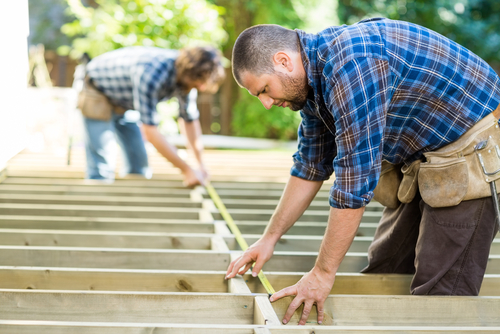Imagine sitting on your deck, feeling the cool summer breeze underneath a star-lit evening sky. It’s quiet and peaceful, until you hear a creak and feel a sudden shift. One of the boards is giving way. Suddenly, your summer night’s dream is turning into a nightmare. Luckily for you, that scenario is completely avoidable. Here we’ll tell you what to look out for and how to build a sturdier, more reliable deck.
Before summer approaches and you start inviting friends and family over for an outdoor barbecue, give your deck a thorough once-over. Are any loose boards or connections? Do you notice any signs of rotting or corrosion? Are there any noticeable cracks? If you answered yes to any of these questions, you may need to have your deck repaired. If there are simply a few loose boards, contact your local lumber supplier to have them replaced. But if you notice several problematic areas, you should have your deck inspected by a qualified professional to identify any major structural issues.
These warning signs may not necessarily be the result of poor construction, but simply degradation from the elements that occurs over time. So be sure to look closely for any signs of wear and tear. For instance, are the nails, screws, or metal connectors rusty? If so, your deck’s structure will likely be weak. Also, be sure to inspect your deck’s railing. Is it loose or wobbly? If you grip it firmly and shake, does it give way? The railing is an incredibly important part of your deck’s structure. People commonly lean up against railings. But if your railing isn’t secure, it won’t be able to support much weight. Inspect the railing as you would the deck and make sure there are no cracks, corrosion, or rotting.
Speaking of weight support, a key to building a better deck is determining how much weight it can carry. Rooms and elevators, for example, have a maximum capacity for the number of people they can hold. Likewise, your deck will have a maximum capacity for the amount of weight it can support. You’ll have to know what that amount is to ensure the safety of those on your deck.
So how do you calculate your deck’s capacity? There are many useful online calculators that will help you figure it out. It’s generally a good idea to use the calculator before you start building. That way, you’ll know the exact specifications your deck will need in order to carry the proper amount of weight. The deck load calculator is a great tool to use. The video tutorial is a great resource to check out as well. The tutorial will explain technical terms like soil bearing capacity and also walk you through what tests you should perform prior to starting construction of your deck.
Once you’ve figured out how much weight your deck will be able to carry, you’ll want to protect it from the outside elements. As with anything else, harsh weather conditions like wind, rain, and snow can cause your deck’s condition to deteriorate. But one way to protect your deck is by creating a continuous load path.
A continuous load path is a method of construction that employs the use of solid connections to transfer the weight of your deck through its frame to the ground and adjoining support structure. Here is an excellent guide on proper deck construction. There are 8 main connections you should have. Here’s a brief rundown:
– Ledger attachment: This is where the deck connects to your home. Be sure to use structural screws rather than nails to attach the deck ledger board to your house.
– Joist-to-ledger: Arranged in a parallel series, the joists support the structure and connect to the beam or ledger.
– Joist-to-beam: The beams are used to support the joists.
– Beam-to-post: Posts are placed underneath the beams to provide support.
– Railing post-to-deck framing: Railings should be securely attached to the deck’s perimeter and to the floor joists underneath the deck.
– Stair stringer-to-deck framing: The stringers are the panels located on the side of the stairs and are fastened to the deck framing.
– Stair tread-to-stringer: Each step, also known as treads, must be secured to the stringer (side of the stairs).
– Post-to-concrete: Post bases connect the posts to the deck’s concrete footing.
It’s important to select quality construction materials to build a deck properly and durably.
Remember that moisture can hasten corrosion (particularly salt water) so your home’s proximity to water can make your deck more susceptible. One way to guard against this is by using stainless steel connectors.
Once you’ve put the time and effort into building a sturdy deck, you should ensure it is properly maintained and regularly inspected. In fact, you should make sure a professional inspects your deck before you even put it to use.
A poorly constructed deck will not only shorten your deck’s lifespan, it will also pose a serious threat to you and your loved ones’ safety. For that reason, it’s important to take great care when constructing a deck. Shoddy work can put you and others at risk. So be sure to consult with an expert lumber supplier and keep your deck well-maintained.
The only creaking you should hear out on your deck is the sound of crickets. So get to building that sturdy backyard deck and enjoying your midsummer night’s dream.
